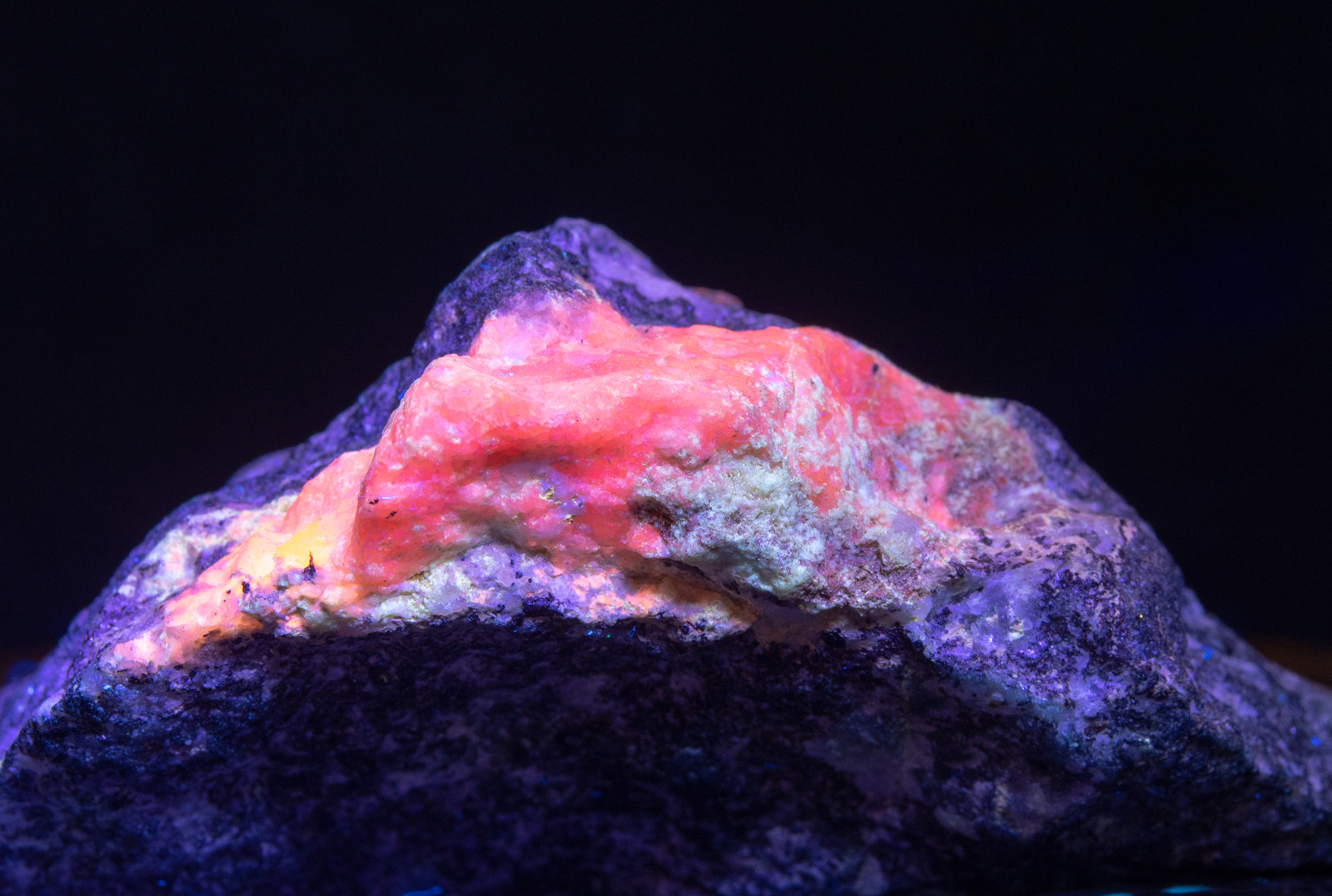
タグトゥパイトの宝石:特性、意味、価値など
 タグトゥパイトは、主に赤またはピンクの色合いを持つ、斑点模様のある宝石です。主にグリーンランドで産出され、「トナカイ石」という愛称で呼ばれています。
タグトゥパイトは、主に赤またはピンクの色合いを持つ、斑点模様のある宝石です。主にグリーンランドで産出され、「トナカイ石」という愛称で呼ばれています。
タグトパイトは希少ですか?はい。かなり希少な鉱物で、ファセットカットされた宝石としては非常に希少です。 コレクターの間でよく知られています。
そうは言っても、タグパイトには圧電性、蛍光性、テネブレセンスなどの魅力的な特性があり、このガイドではこれらすべてについて詳しく説明します。
一緒にタグパイト宝石の効能、価格、歴史などの秘密を解き明かしましょう!
 画像クレジット: Jessa and Mark Anderson、 Flickr 、 CC-BY-SA-2.0
画像クレジット: Jessa and Mark Anderson、 Flickr 、 CC-BY-SA-2.0
タグトゥパイト石とは何ですか?
トゥグトゥパイトは、最近発見された半貴石で、1960年代からその存在が知られるようになりました。この希少な石はグリーンランドで発見され、「トナカイの血」を意味するトゥクトゥとも呼ばれています。これは、グリーンランドのイヌイット語で「トナカイ」を意味する「tuttu」に由来しています。
占星術的に、タグトゥパイトは獅子座に利益をもたらします。
ピンクと白、あるいはピンクと黒の縞模様を持つ場合、この石はロードクロサイトやロードナイトといった宝石に似ているかもしれません。しかし、ロードクロサイトはマンガンケイ酸塩、ロードナイトは炭酸マンガンであり、タグトパイトにはマンガンが含まれていません。
見た目は異なりますが、タグパイトとソーダライトはより密接に関連しており、一緒に成長することがよくあります。
科学者たちは、さまざまなソーダライトグループの鉱物がどのように発光するかを研究するために合成タグタパイトを作成したが、合成タグタパイトは宝石としての使用を目的に作られたことはない。
タグトパイトの仕様と特徴
タグトパイトは、塩素とナトリウムを含むベリリウムアルミニウムテクトケイ酸塩です。鉱物化学式はNa4AlBeSi4O12Clです。一般的な不純物としては、鉄、ガリウム、硫黄、マグネシウム、カリウム、カルシウム、水などがあります。
この鉱物は、長石に似たテクトケイ酸塩鉱物の類長石鉱物グループに分類されますが、シリカ含有量が少なく、構造が異なります。他の類長石鉱物には、アフガナイト、ペタライト、ソーダライトグループ鉱物などがあります。
より具体的には、タグトゥパイトはヘルビン鉱物グループの一部であり、ソーダライトのサブグループと見なされることもあります。
タグパイトの晶癖には、蝶形(四面体、くさび形、閉じた形状)またはピラミッド状の短柱状結晶、塊状結晶、細粒集合体などがあります。結晶は、擬立方三重項を形成する貫通双晶、または擬三方接触双晶を示すことがあります。
 上の写真:UVabc光照射後のリン光状態にあるタグトゥパイトとチカロバイト標本|画像提供:Cran Cowan、 Flickr 、 CC-BY-SA-2.0
上の写真:UVabc光照射後のリン光状態にあるタグトゥパイトとチカロバイト標本|画像提供:Cran Cowan、 Flickr 、 CC-BY-SA-2.0
タグトパイトの光学特性
前述のように、タグパイトには驚くべき特性がいくつかあります。
まず、強い蛍光(X線や紫外線下で光る)と燐光(「暗闇で光る」物質のように長時間光る)を発します。「蛍光鉱物の王様」と呼ばれることもあります。
しかし、最も印象的なのは、タグトゥパイトのテネブレセンス、つまり「可逆的なフォトクロミズム」です。
宝石における最も稀な光学現象であるテネブレセンスは、特定の種類の光(通常は太陽光などの紫外線)にさらされた後に石の色が変化した後、元の色に戻る現象です。この変化は、石の色合いに永続的な影響を与えることなく、繰り返し発生することがあります。
色が変わる宝石とは異なり、テンブレセント宝石はさまざまな光にさらされると徐々に色が変わります。
そのため、暖かさと紫外線(日光など)への露出により、タグパイトの色がより濃くなり、多くの場合、淡いピンクから鮮やかな緋色に変化します。
他に暗色になる宝石は、スカポライト(まれ)、スポジュメン、ソーダライトの一種であるハックマナイトだけです。
以下に、タグトゥパイトの特性をすべて示します。
モース硬度:4~6.5
色: 一般的には白、ピンク、バラ色、深紅、緑。まれに青。斑点模様が一般的。
結晶構造:正方晶
光沢:ガラス質、亜ガラス質、蝋状、鈍い、または脂っぽい
透明性:半透明から不透明
屈折率:1.496-1.502
密度:2.11~2.60
劈開:{101} では明瞭/良好、{110} では普通
骨折:不規則または貝殻状
縞模様:白
発光: 蛍光あり - 長波紫外線よりも短波紫外線で強いバラ色、または短波紫外線ではサーモンレッド、長波紫外線ではオレンジ色。リン光あり - 明るいクリーム色からオレンジクリーム色、または鈍い赤からクリームホワイト。X 線 - 淡い色を暗くする。
多色性:あり、弱〜強 - 青みがかった赤からオレンジがかった赤、またはライラックから赤オレンジ
複屈折:0.006-0.008; 異常二軸
分散:0.012
光学現象:テネブレセンス
トゥグパイトの形而上学的特性と意味についてはどうでしょうか?
 画像クレジット: 親の Géry、 CC-BY-SA-3.0
画像クレジット: 親の Géry、 CC-BY-SA-3.0
タグトパイトの意味と歴史
トゥグトゥパイトは楽観主義、調和、そして愛を象徴します。トゥグトゥパイトのスピリチュアルな意味は、かつて失ったり忘れたりした情熱や愛に火をつけることだと解釈する人もいます。
石は日光の下では色が濃くなり、暗闇では色が薄くなる性質があり、自分の内なる光を輝かせることを思い出させてくれます。
グリーンランドでは、タグトゥパイトは多くの伝説に影響を与えてきましたが、最も有名なのはツツの物語です。
イヌイットの伝説によると、「トナカイの娘」トゥトゥは最初の子供を出産するために山を登りました。出産時に出た血が山の石に混じり、トゥトゥパイトが生まれました。
歴史
トゥグトゥパイトは、1957年にデンマークの鉱物学者ヘニング・ソーレンセンによってグリーンランドのトゥグトゥプ・アグタコルフィアで初めて発見されました。この鉱物はイリマウスサック複合岩体と呼ばれる地域で発見されましたが、これは1811年にヨーロッパの探検家が初めてソーダライトを発見したのと同じ地域です。ソーダライト以外にも、アルフヴェドソナイトやユーディアライトなど、他の多くの鉱物の基準産地でもあります。
「タグトゥパイト」という名前は、この最初の産地と、グリーンランドのイヌイット語で「トナカイ」を意味する「タグトゥプ」に由来し、「トナカイ石」というニックネームが付けられました。この石の赤い色が、有名なトナカイのルドルフの赤い鼻に似ていることも、このニックネームの由来となっているのかもしれません。
しかし、この石の最初の名前はベリリウムソーダライトでした。ロシアの鉱物学者エフゲニー・イワノビッチ・セミョーノフとアレクサンドラ・ヴァシリエフナ・ブイコワは、1960年にロシアでタグトパイトの発見を発表しました。この石への関心が広まったのは、1962年にグリーンランドの別の地域で発見された後のことでした。
ソレンセンは1963年に「タグトゥパイト」という名称を提案し、1965年に国際鉱物学協会(IMA)によって承認されました。最初のタグトゥパイトの宝石も1965年に販売されました。
ヌーマイトと同様に、タグトゥパイトの豊富な宝石産地はグリーンランドのみです。残念ながら、この石は発見以来、著しく希少になっています。
形而上学的な側面に戻りますが、タグパイト結晶の治癒特性とは何でしょうか?
トゥグトゥパイトの治癒特性
主にピンク色のヒーリングストーンであるタグトゥパイトは、ハートチャクラストーンであるとともに、受容と愛をもたらすという点で他のピンク色の宝石に加わります。
タグパイトは身体にどのような効果をもたらしますか?
身体の治癒
身体的には、タグパイト結晶は次のような効果があると言われています。
ホルモンバランス
不妊
血液循環
心臓の健康
感情的な癒し
感情面では、タグトゥパイトは、特に過去の苦難や裏切りに起因する、皮肉やネガティブな感情に悩む人に効果があります。この水晶は、失恋の後に愛を受け入れ、再び自分自身を愛せるようになるのを助けてくれると信じられています。
上の写真:LW-UV光下でのタグトゥパイト|画像提供:Géry PARENT、 CC-BY-SA-3.0
タグトパイト宝石の特性
希少性に加えて、タグトゥパイト宝石の価値は色、カット、クラリティ、透明度、カラット重量によって決まります。
色
トゥグトパイトの宝石によく見られるピンク色は、硫黄を含む色中心によるものです。通常、斑点状の他に、黒、白、そして時には緑などの色も見られます。青色は珍しく、カットされた青いトゥグトパイトのカボションは12個にも満たないと思われます。
一般的に、白や黒よりも赤やピンク色の石の方が価値が高くなります。
コレクターの間では、強い多色性、テネブレセンス、ルミネセンスも重要です。
カット
多くの場合、タグトゥパイトはカボションカット、彫刻、またはカットされていない原石(原石)として販売されます。 ファセットカットされたタグトゥパイトは非常に希少で、価値が高いです。
明確さと透明性
クラリティとは、宝石に含まれる目に見える内包物の度合いのことで、内包物は宝石の透明度と価値を低下させる可能性があります。タグトゥパイトの標本には通常、黄色の斑点や黒い針状のものなど、内包物が多く見られます。内包物が少なく、透明度が高いほど価値が高くなります。
カラット重量とサイズ
ファセットカットされたタグトパイトはごくわずかで、いずれも小粒(1~2カラット)で、完全にインクルージョンフリーというわけではありません。半透明のタグトパイトのほとんどはカボションカットされ、大きな標本は装飾品としてカット(または原石のまま販売)されることが多いです。
 上の写真:LW-UV光下でのタグトゥパイト標本|画像提供:Géry PARENT、 CC-BY-SA-4.0
上の写真:LW-UV光下でのタグトゥパイト標本|画像提供:Géry PARENT、 CC-BY-SA-4.0
タグトゥパイトの形成と産地
タグトゥパイトは、貫入火成岩、主に霞石閃長岩ペグマタイト内の熱水脈に形成されます。ソーダライト族鉱物は、通常、火成岩の形成過程において、火成岩内部のナトリウムを豊富に含むマグマから結晶化します。
タグトパイトは、ベリリウムケイ酸ナトリウムのチカロバイトを置換することによっても形成されることがあります。
タグトパイトと一緒に発見された関連鉱物には以下のものがあります:
採掘場所
宝石品質のタグトゥパイトはほぼすべて、グリーンランドのタセク地域とクヴァネフィールド地域から産出されます。他に知られている産地はカナダとロシアのみです。
トゥグトゥパイトの希少性の一つは、グリーンランドでの採掘が極めて困難であることです。採掘者は船や徒歩で高山まで行き、鉱石を袋に入れて持ち帰らなければなりません。
 上の写真:UVライトでセッティングしたタグトゥパイトのペンダント(18Kゴールドにセット)|画像提供:Jessa and Mark Anderson、 Flickr 、 CC-BY-SA-2.0
上の写真:UVライトでセッティングしたタグトゥパイトのペンダント(18Kゴールドにセット)|画像提供:Jessa and Mark Anderson、 Flickr 、 CC-BY-SA-2.0
トゥグトゥパイトの価格と価値
このように希少な宝石であるため、販売されているタグトパイトの価格はかなり高くなることが予想されますが、それでも多くの貴重な宝石よりは低くなります。
低品質のファセットカットされたタグトゥパイトの中には、1カラットあたり約30〜40ドルで見つかるものもありますが、ほとんどは1カラットあたり約270〜480ドル以上です。
タグトゥパイトのカボションの価格は 1 カラットあたり約 8 ドルから 240 ドルの範囲ですが、ほとんどは 1 カラットあたり約 20 ドルです。
ピンク色のタグトパイトのカボションペンダントは約100ドルから2,200ドルですが、原石のペンダントは通常30ドルから100ドルです。タグトパイトのリングは通常200ドルから500ドル、イヤリングは約200ドルから250ドルです。
最後に、タグトパイトの宝石のケアについて説明します。
タグトゥパイトのケアとメンテナンス
モース硬度が低く、はっきりとした劈開を持つため、タグパイトのジュエリーは壊れやすい場合があります。ペンダントやイヤリングをおすすめします。タグパイトの指輪は、保護セッティングが施されたもののみをご使用ください。
トゥグパイトは、中性洗剤、ぬるま湯、柔らかい歯ブラシで洗ってください。機械洗浄機は使用しないでください。傷がつかないように、他の宝石とは分けて保管してください。
 上の写真:UVcライト下のタグトゥパイトとチカロバイト標本|画像提供:Cran Cowan、 Flickr 、 CC-BY-SA-2.0
上の写真:UVcライト下のタグトゥパイトとチカロバイト標本|画像提供:Cran Cowan、 Flickr 、 CC-BY-SA-2.0
あなたの心の琴線に触れるタグトパイトはありますか?
宝石コレクターは、その美しい色彩と紫外線への反応からタグトパイトを崇拝し、クリスタルヒーラーは、人生に純粋な愛をもたらすとされるこの水晶を高く評価しています。どちらの立場であっても、タグトパイトには愛すべき点がたくさんあります!
Gemstone Encyclopedia検索
最新記事
レインボーラティスサンストーンは、様々な内包物によって3つのゴージャスな光学的効果を持つ長石の一種です。燃えるように鮮やかな色合いと格子模様が、コレクターにとって希少な宝石となっています。
12th Jan 2026
チューライトは、ゾイサイト鉱物ファミリーに属する、鮮やかなバラ色の色合いを示す希少なノルウェー産の宝石で、ジュエリーのセッティングやペンダントによく使用されます。
6th Jan 2026
記事のカテゴリ
How To's is where you will find helpful articles from gem Rock Auctions on how to cut gemstones, select gemstones and buy gemstones.
9記事数
